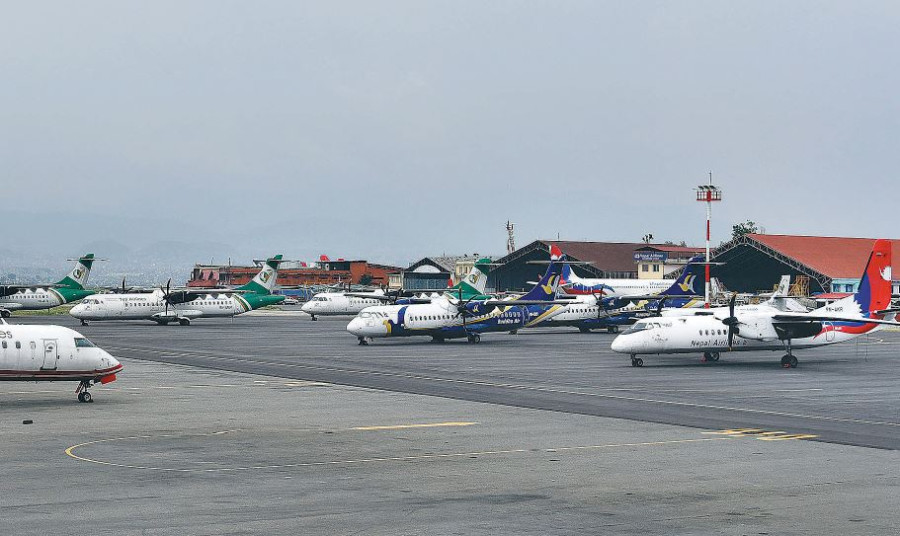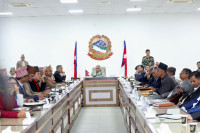National
Nearly collapsed domestic airlines set to take to the skies again after six months
The upcoming festival season may provide respite for carriers, but with reduced incomes of people and no signs of the pandemic subsiding anytime soon, operators are worried about their survival.
Sangam Prasain
Bowing down to pressure from domestic airline operators, the government has decided to scrap its directive issued last week to them to fly half-empty to ensure social distancing measures within the confined space of the aircraft to prevent the spread of Covid-19.
With the latest development, domestic airlines are set to take to the skies again on Monday, nearly six months after their aircraft were grounded.
Operators, who have been incurring massive losses and teetering on the verge of bankruptcy, have welcomed the revised decision.
“We are excited to serve again after six months,” said Sudarshan Bartaula, spokesperson for Yeti Airlines, a company with an extensive network across the country.
On September 15, the government had announced that domestic airlines would be allowed to resume services from September 17, but only if they fly with passengers half their capacity.
Private operators were quick to oppose the decision, saying they could not fly the planes half-empty. They warned that they would not fly any scheduled passenger flights until the government rolled back its decision.
“Now the airlines are allowed to fly in their full capacity,” said Kamal Prasad Bhattarai, spokesperson for the Tourism Ministry. “However, there are many other provisions that the airlines should follow to implement the health safety protocols.”
Such protocols are, however, mainly focussed on preventing crowding at airports.
One of them is airlines are allowed to operate only 25 percent of their flights. This means, for example, if an airline used to operate 100 flights during the pre-Covid period, it can now only operate 25 flights.
"This is a trial. This will bring down the number of daily flights to 100 from 400," said an official at the Tourism Ministry.
This provision will, however, be in place only until September 30.
“After October 1, airlines will be allowed to increase the flight frequency to facilitate passengers in view of the upcoming festive season,” said Suresh Acharya, joint-secretary at the ministry.
Nepal sees the biggest internal people’s movement when Dashain starts. Fulpati, the seventh day of the 10-day long festival, the time when the movement peaks, falls on October 23. Millions of people travel during the festive season every year—hundreds of thousands by air—bringing a bonanza for airlines as seats are fully sold out.
Other safety measures that the government has come up with include all domestic passengers must fill up a declaration form on their health history before the airline issues the boarding pass, airlines must inform every passenger as early as possible through a text message if there is a flight delay, passengers must not be kept waiting at the airport and as soon as they clear the airport security, they have to be bussed to the aircraft. Masks will be compulsory for all passengers.
Airlines, for their part, will provide masks and face shields to all passengers on each flight, ensure enhanced cleaning of aircraft with a focus on high contact areas like seats and seatbelts, screen temperatures of passengers twice before boarding, will make check-in contactless, limit passenger movement around cabin once they are seated, have sequenced boarding and disembarkation to minimise crowding, and not allow passengers hand carry baggage, except for women’s bags and laptop bags, inside the cabin.
Passengers must get to the airport one and a half hours before their flights.
“We have completed all the preparations on our part,” said Bartaula of Yeti Airlines.
According to him, Yeti Airlines is scheduled to operate 11 flights to Pokhara, Biratnagar, Bhadrapur, Janakpur, Bharatpur, Bhairahawa, Nepalgunj, Tumlingtar and other destinations on Monday.
“In some sectors like Bharatpur, we have 100 percent occupancy, while in others, we are 70 percent sold out,” he said.
He said that airfare will not be increased. “Instead, more tickets are offered at the lowest fare. For example, airfare on the Kathmandu-Bhadrapur sector is available at Rs3,800, against the normal fare of Rs8,900,” he told the Post.
According to airline officials, they have floated around 25 percent of the seats at lower fares.
One destination airlines will not be immediately flying to is the Everest region.
While the government has allowed foreign tourists into Nepal for trekking and mountaineering from October 17, Khumbu Pasang Lhamu Rural Municipality has made it mandatory for all visitors, including Nepalis, to submit negative Covid-19 RT-PCR test reports not older than 72 hours before they are allowed entry.
“As of now, the Everest region has zero virus cases. The municipality has taken the decision in order to make it a Covid-19-free region,” said Binod Bhattarai, chief administrative officer at the Khumbu Pasang Lhamu Rural Municipality.
According to Bhattarai, the decision has been circulated to all airlines and the Civil Aviation Authority of Nepal. “However, if a passenger flight is delayed or postponed, thus exceeding the 72-hour timeframe of the PCR report, the municipality will consider such cases,” Bhattarai told the Post.
The Everest region is the second most preferred trekking route after Annapurna. In 2019, more than 57,000 people trekked there.
If travellers come without a report by air or on foot, they will be put into quarantine for 14 days at their expense which is estimated to cost Rs4,000 per day, according to Bhattarai. However, for local people who cannot afford quarantine costs, the municipality will pay, said Bhattarai.
Despite the fact that they are allowed to fly, airlines are still uncertain about the future and they see the aviation industry full of challenges as there are no signs of the contagion abetting anytime soon.
“The airline travel may bounce for the moment due to the demand triggered by the upcoming festival rush, but virus spikes could reverse the situation soon,” said a private airline official, who wished to remain anonymous. “Airlines have incurred massive losses but we have decided not to increase airfares. But how long will we be able to offer inexpensive seats?”
According to the Airlines Operators’ Association of Nepal, domestic airlines are losing Rs1 billion in revenue every month. A company like Buddha Air, which has over a dozen aircraft, is losing Rs500 million monthly, said Yog Raj Kandel, spokesperson for the association, in a recent interaction organised by the Society of Economic Journalists-Nepal.
Further, since aircraft need at least a week of maintenance before they are allowed to fly, some of the nine fixed wing airline operators may not start operations on Monday.
The fact that people’s incomes have gone down due to the pandemic will also mean fewer people will opt to fly.
“People do not have enough money to travel on planes,” said Anil Manandhar, corporate manager at Shree Airlines. “With the festivals ahead, there may be demand initially, but after the season ends, airlines will again struggle to get flyers.”
Nepal’s economy is anticipated to grow by 1.5 percent in the current fiscal year 2020-21, down from the preliminary estimate of 2.3 percent in the last fiscal year, according to the Asian Development Outlook 2020 Update.
Manandhar of Shree Airlines admitted that airlines will vie for fierce competition to attract passengers. This could result in reduction of airfares, and operators wonder how sustainable it could be.
“The industry is in survival mode. All airlines are desperate to conserve their cash reserves as their revenue streams have dried up,” said Manandhar. “Offering a low fare policy may help a few airlines to survive for now, but in the long run, they may face bankruptcy even when they are flying their aircraft.”




 15.12°C Kathmandu
15.12°C Kathmandu




.jpg&w=200&height=120)










